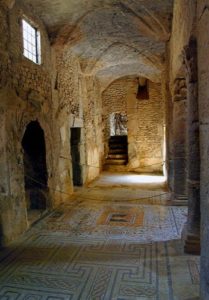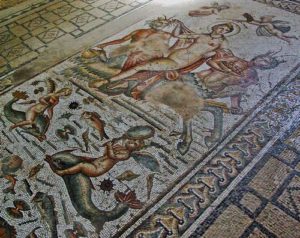This is in a lovely setting in a very fertile wheat growing area surrounded by mountains.
The area has been settled since the fifth century when Carthage began to develop the Medjerda valley as wheat growing area. After the fall of Carthage, it became the capital of one of Numidian Kingdoms which was tolerated by tolerated by Rome, later becoming part of the Roman Empire in 1stC AD. The present remains date from the 2-3rdC. It was a prosperous city as it provided wheat, grains, grapes and olives to the rest of the Empire. Italian agriculture was devastated by the Second Punic War and social uprisings during the last years of the Republic and relied on its African colonies to meet the demand for wheat and olive oil as it was only 3-5 sailing days from Rome’s main port of Ostia. This part of Tunisia had fairly reliable winter rains, mild frost free springs and plenty of summer sun. The town was abandoned in 7thC after the Arab conquest.
The ruins are laid out on terraces on the steep slopes of Djebel Rebia (647m) overlooking the plain. Only 25%of the site has been excavated. It is unique as buildings were partially constructed underground as a protection against the fierce heat of the sun in the summer and cold winters. Many of the underground houses are well preserved and still have mosaics in situ. Seven have been excavated.
There is a small ticket office with museum and cafe across the road from the site. To the left of the entrance is a row of massive cisterns which fed the Memmian Baths. These are massive with walls standing to nearly their full height and a splendid portico to the north. The rooms along the east and west walls were gymnasia. There is a changing room with Frigidarium (cold bath) in the middle of the building. In the south east corner is the Cauldarium Hot bath) with a small steam bath off. However there is little left inside the building apart from the walls.
The road from the Memmian baths leads to the Treasure House, so called because a cache of 7thC Byzantine coins was found here. It is the first of the underground houses. Access to the underground rooms was shut when we visited to protect the mosaics and we had to admire from the top. We could see the pipes which were used in the construction of the walls to increase insulation.
Beyond this along the road were the remains of two small 6thC Christian Basillicas. One still has the remains of a baptistry with some nice mosaics around it.
The road leads to the main residential area. The House of the Hunt is huge with a large courtyard with pillars and baths at ground floor level. Steps to the underground rooms were also closed off as the mosaics were being restored.
We then got picked up by an old man who was hovering around the site and took us to the House of Amphitrite at the edge of the excavated site and showed us the way down into the underground courtyard with pillars There are three main rooms with two smaller chambers. The mosaics had been dampened to show off the colours of the tesserae. One had a beautiful head of Neptune in the centre and another showed Venus flanked by two centaurs. Below are two figures described as Cupid both riding a dolphin. One is holding a mirror. Below different sorts of fishes are swimming in the sea. With the eye of faith the remains of plaster can be seen on the walls.
On the way back to the forum we passed the Nymphaeum which provided the water for the town. the spring is still in use today and there is a large pool which is popular with the local youths for swimming. Where the spring crosses the road, the local women were busy washing clothes.
Apart from the large paved square, there is little left of the Forum area and only the foundations of the Capitol survive. Beyond are the remains of the theatre but again little survives of this apart from the outside walls.
Well worth visiting. Most of the site is accessible for people with mobility problems although the steps down into the underground houses may pose problems.









